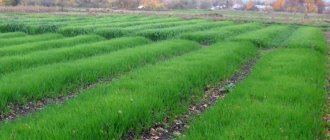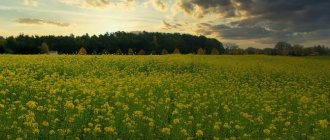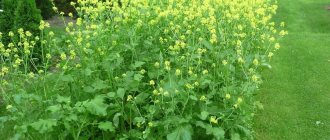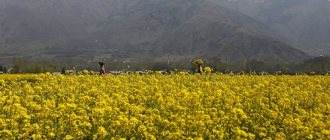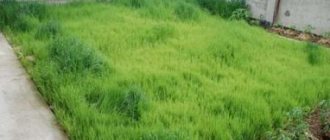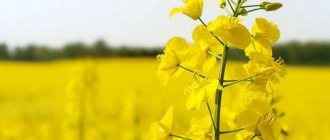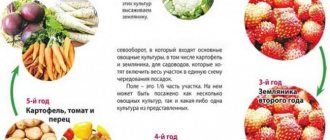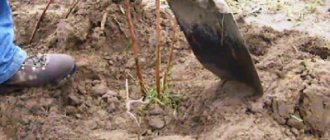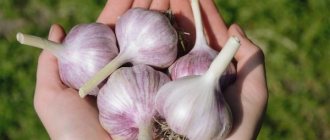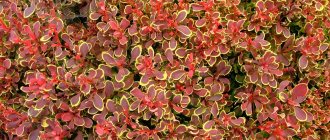Advantages or why to sow mustard in the fall?
This green manure is accessible to any gardener, easy to grow and effective. Its main purpose as a fertilizer is to enrich the soil with phosphorus and nitrogen. Green mass dug into the ground transfers these important elements to subsequent plants, stimulating the process of their growth and development. In addition, mustard has the following beneficial features:
- Fast germination and high yields. Green mass is a complete fertilizer in composition.
- High cold resistance. The sprouts can withstand temperatures down to -5 C. After a significant cold snap, the plants protect the soil from freezing and help retain moisture until spring.
- Essential oil content. Mustard copes with plant diseases such as scab and late blight; protects against the Colorado potato beetle, slugs, and weeds. This quality manifests itself when grown interrow with potatoes, grapes, and beans.
- Lack of seed preparation. They are placed in the soil, covered with a small amount of earth, sand, or covered with a rake.
- Strong root system. Reaches 0.5 meters and loosens the earth to this depth. It can absorb elements that are slightly soluble in water and for this reason are inaccessible to other plants.
- Increased air permeability of the ground. It is achieved by increasing the number of earthworms after sowing mustard in the fall.
- Prevention of erosion. Dense sowing is used where there is a risk of soil erosion and wind damage. The stems of plants planted in early autumn will be able to perform the function of snow retention before frost.
1. WHAT IS MUSTARD GOOD AND HEALTHY, CAN YOU MAY BE IN MORE DETAIL?
Mustard seeds can be purchased at any store.
Its amazing flowers will delight the owners of the site for a long time if they are planted directly in the ground in the spring. No additional care is required, so green fertilizer will quickly turn into an irreplaceable material. What are the benefits of such a plant? High yield; Minimal care; Supply of useful substances. People have been using mustard stems as biomass for a long time. Its introduction into the soil adds a large amount of useful substances. It is profitable to grow it on your own plot in order to get enormous savings by abandoning almost all other fertilizers. High yield Mustard as a necessary fertilizer for the garden in the fall was not chosen by chance. It is enough to plant 1 acre to get 22% more biomass from it than from traditional weeds. It can be used to fertilize any soil without thinking about its composition or checking the condition of the plantings. After flowering, the finished green stems should be mowed, and then humus should be placed in the garden plot before winter. The harvest and high germination completely pay for the occupied space, so it should not be saved. Minimal care How to sow mustard? Like any lawn, freely scattering small seeds in the open area. In the spring you won’t have to make beds in advance; you don’t have to worry about it, since the plant will fill the free space on its own. During growth, watering is not required, which is carried out by drip in dry years, but on chernozem soils, even this is not necessary. Mustard fertilizer is the simplest option, which is worth using if you don’t want to buy chemicals again in the fall. Supply of nutrients When to plant plants? This can be done immediately after the earth warms up; this species does not require additional conditions, but it is better to do it earlier. Why is this necessary? The biomass must gain the maximum amount of useful substances, and sufficient time should be left for this. This option is to make overwintered humus as useful and profitable as possible. Next year, only digging will be required without additional processing. What are the benefits of mustard? People rarely decide to plant mustard in their own gardens. Usually they were considered part of vast fields, but even at home you can get a large harvest. Using simple principles, it will be possible to achieve a huge volume of biomass, which will subsequently be converted into fertilizer. What substances does it contain? 22% organic matter; 0.92% phosphorus; 0.71% nitrogen; 0.43% potassium. Sowing mustard to fertilize the soil makes it possible to collect a complete complex fertilizer. This product will become an ideal replacement for traditional chemical compounds. Usually you have to separately select substances for each microelement, but with the help of nature it is possible to immediately enrich the soil. 2. WHAT ARE SIDERATING PLANTS?
White mustard in the struggle for the harvest.
Every gardener knows that the harvest depends on the nutritional value of the soil. The more organic and mineral substances it contains, the more nutrition the plant will receive. Vegetables and flowers, trees and shrubs love fertile soil. And in order for the earth to delight us with fruits year after year, it requires constant care. Our grandmothers achieved the fertility of the soil and favorable soil microflora through natural methods - applying organic fertilizers (manure) and planting green manure plants that can simultaneously disinfect and enrich the soil in the fall. What kind of plants are these, and how do they affect the fertility of the earth? In this article the story will be about white mustard, an assistant and a nurse. But first, let's figure out what green manure is. Green manure in the struggle for the harvest. There are many green manure plants, and the list is long. Here are some of them: white mustard, rapeseed, rye, wheat, buckwheat, rapeseed, lupine, clover, peas, beans, sweet clover, phacelia, etc. These crops grow very quickly and manage to produce dense green mass before the cold season. Typically, green manure plants are planted at the end of summer, when the beds are already free of vegetables. And in the fall they either dig them up or leave them in the garden bed, creating a fertile layer. They can serve as winter shelter for grapes, roses and other capricious plant species. To do this, simply sow green manure under the bushes. As for large areas, they should be sown in early autumn, and after waiting for good seedlings, it is better to plow them before the cold weather, then the soil will receive maximum nutrition from the green manure planted in the ground. You can simply mow it and leave it on the surface without digging, and in the spring embed it into the soil. You can sow these soil-enriching plants in early spring. A week before the main landing. Each gardener chooses an already familiar green manure for himself and plants it for a specific purpose, since each one has a very necessary function. 3. WHAT FUNCTIONS DO GREEN MANAGEMENTS PERFORM?
Enrich the soil with micro- and macroelements.
This is an excellent nutritional base for beneficial underground inhabitants. They are excellent honey plants for pollinating insects. Prevents the development of weeds. Prevents the accumulation of pests and pathogenic bacteria. Drain the soil without letting it dry out. They protect the earth from direct sunlight. They are perfectly absorbed by the fertile soil layer. They are an additional source of food for livestock and domestic animals. Able to grow on any, even the heaviest soils. They process substances that are not absorbed by vegetables and other cultivated plants. As an excellent green manure, white mustard is well known to gardeners. White mustard - assistant and nurse. This modest annual plant of the cruciferous family is an excellent green manure and has a lot of advantages. It has excellent resistance to diseases such as late blight and scab; it is recommended to be planted next to potatoes. It destroys harmful insects, wireworms and slugs, as well as the pea codling moth, so it is an excellent protector for legumes. It has melliferous properties, attracting pollinating insects, helping to pollinate many fruit crops, such as raspberries, strawberries, blackberries. Due to its deep root system, it perfectly loosens and drains the soil, making it permeable to air, this is especially useful for damp, heavy areas. Retains nitrogen and can change soil acidity through leaching. It is an excellent mulch at any time of the season, and in winter it serves as an excellent shelter for bushes, trees and flowers. Unpretentious and frost-resistant. It has a high yield and quickly grows green mass, even after pruning. Here it is, white mustard, a modest worker and an irreplaceable helper in our gardens. Thus, planting it is a natural and simple way to restore the balance of soil fertility. Applying manure does not have the same effect as planting mustard and working it into the soil. After it, the soil enjoys natural gifts for many years. Mustard can be planted and replanted constantly, throughout the season, in vacant beds, under fruit trees and around the perimeter of the site. It will help control weed aggressors. Let's consider several ways of sowing and incorporating useful crops into the soil in different seasons. 4. SHOULD WHITE MUSTARD BE PLANTED IN AUTUMN?
White mustard as a good fertilizer - planting in autumn: As has already been written, you can start sowing mustard in mid-summer, when the first beds are cleared, and continue until mid-autumn, if the weather permits and there are no severe frosts. This green manure, as a fertilizer, when planted in the fall, performs several functions at once. Sowing is done by scattering the seeds and covering them with a layer of soil. If these are large potato areas, plant the mustard seeds more carefully, as our feathered friends can peck out up to half of the crop. If you are sowing it in vegetable beds, then it is better and more reliable to cover the sowing with non-woven material. And as soon as the shoots emerge, it can be removed. But it should be remembered that sprouts will appear faster where the planting depth is shallower. Usually on the fourth or fifth day, the area is already covered with sprouts, which feel great even at zero temperatures. Mustard crops can easily withstand night frosts down to -5 degrees. You should not dig up all this green mass in the fall. You may lose 80% of the effect. As soon as the perfect environment in the soil has been established, its structure has formed, and you are destroying it with your own hands. The communities of microorganisms necessary for the soil are also disrupted. The green mass simply rots. Leave the mustard in this form over the winter. It will also serve you as mulch. The structure and warm “coat” for beneficial insects and microorganisms will be preserved. Keep in mind that if you planted it late in the fall, so much greenery will not have time to grow, this is not a problem. The root system will do its important job, because the roots go deep into the soil, 2-3 meters. In the spring, its preserved stems will delay snowmelt, which means the earth will be well saturated. In the fall, to improve the health of the soil, mustard is sown at the rate of 400 grams per hectare of land. And if you planted it earlier and want to get green fertilizer, take 150-200 grams per hundred square meters. In this case, it needs to be mowed before the formation of buds, approximately 40 days after germination. In the spring, sow this unique crop as early as possible, as soon as the soil thaws and warms up a little. You can sow it in greenhouses, then before planting cucumbers. When the mustard sprouts and grows a little, you can dig up the soil and cover it with black film. Before planting cucumbers, your beds will be completely prepared. There is only one circumstance that needs to be taken into account when planting white mustard in the fall, for green fertilizer. Do not plant it in beds and areas where you will plant cruciferous vegetables next year: cabbage, turnips, radishes. These vegetables must have other predecessors - green manure from the cereal or legume family. The fact is that mustard suffers from the same diseases as cabbage and turnips. White mustard as a fertilizer is a unique and universal remedy. It helps the soil maintain the necessary nutritional balance, which promotes the rapid and healthy growth of vegetable, fruit plants and flowers. Plant this wonderful green manure and your harvest will be rich!
Disadvantages of autumn sowing mustard as green manure
The disadvantages gardeners include:
1. Transition to weed. If you don’t mow the mustard until the last minute, it will harden and bloom. The cut seeds will most likely fall into the ground and germinate. This garden weed is difficult to remove from the soil.
2. Limited use. White mustard should not be grown in the fall where other cruciferous vegetables, such as radishes, turnips, and cabbage, will have to be planted the following season. These crops are susceptible to the same diseases and pests as mustard. It is better to plant cereals and legumes in front of them.
When exactly is mustard planted in the fall?
The sowing time depends on the weather conditions in the region and the wishes of the gardener regarding the expected seedlings and the green manure period. Autumn planting of fertilizer is carried out during the following periods:
1. Late summer, early autumn. Sowing is done in moist soil after harvesting. Green manure grows well in large areas where there were previously potatoes, strawberries, and cereals. Usually there is enough time from the moment of sowing to the beginning of flowering to obtain the required amount of green mass. So, when adding seeds immediately after harvesting, from 1 hundred square meters you can get about 400 kg of fertilizer, which needs to be mowed and applied as intended.
2. At the end of September. When planting late, the grown stems are not mowed; they die from frost and save the soil from the cold in winter. The roots, being in the ground, rot, feeding and loosening the soil.
3. Before winter. Mustard is sowed in late autumn so that the fertilizer germinates in the spring. To do this, the seeds are placed in dug up cold soil and left there to overwinter. To prevent the mustard from freezing and being washed away by melt water with the soil layer, you need to increase the depth of planting.
What period of autumn is recommended for planting?
REMEDY FOR FOOT FUNGUS More than 65% of people in our country are infected with a mild form of nail fungus and don’t even know it! Many people who used the NEW ointment got rid of fungus and were satisfied with the results. Continue reading
When and how to sow mustard as green manure in the fall? In different regions, sowing time varies, which is due to the climatic characteristics of the area. Experienced farmers recommend sowing white mustard using the following technology:
- Late summer, early autumn. Mustard seeds are sown in moist soil after harvesting. In areas where cereals and potatoes previously grew, green manure grows especially well. The farmer manages to obtain the required amount of green manure even before the first signs of flowering. If you sow mustard immediately after harvesting, you can remove four centners of green mass from one hundred square meters, which will be used to fertilize and aerate the soil.
- In the last days of September. Late planting is convenient because the stems do not have time to harden, so there is no need to mow them. At the first frost, the plants die, lie down on the ground and shelter it from the cold. The root system rots, loosening the soil and saturating it with minerals.
- Sowing just before winter assumes the emergence of seedlings in early spring. Mustard seeds are sown in cold soil after digging. To prevent the seeds from being washed away by melt water, it is recommended to increase the sowing depth.
How to sow mustard correctly in the fall
To create high-quality fertilizer, growing green manure must follow the following algorithm:
1. The beds should be freed from remnants of vegetables and weeds after harvesting.
2. It is advisable to fertilize them with humus at the rate of 1 bucket per 1 square meter. m.
3. The ground needs to be dug up, leveled with a rake, and watered.
4. Next, you should start planting mustard in rows. The seeds are similar in size to small beans and are easy to grab and place in the soil. The distance between them should be at least 15 cm, between the rows about 20 cm, as the plants grow.
5. About 250 g of seeds are planted per hundred square meters of land. They should not be placed too far into the soil, this will slow down germination; the optimal depth should not exceed 1–1.5 cm. If there is not enough time, you can not sow mustard in rows, but scatter it in random order on the ground. The result will be worse than in the case of uniform application, but still noticeable.
6. After planting mustard in the fall, the seeds are dug in a little or harrowed with a regular rake.
Plants sprout approximately 4 days after sowing; after a month, their height is 15 cm. For full growth and development, mustard should be watered abundantly; it does not need additional feeding. It is advisable to cut off green manure shoots before flowering for the following reasons:
• stems and leaf petioles become coarser with the appearance of flowers, which slows down the processing of green mass and the formation of fertilizer;
• flowering consumes plant nutrients, which contributes to the loss of green manure function;
• mustard with seeds will begin to multiply and can quickly turn into a difficult weed.
Growing mustard for seeds
It is usually not difficult to purchase planting material for this green manure; moreover, the consumption during planting is only 250 grams per hundred square meters. At the same time, a thrifty owner can always grow mustard on his own; to do this, you need to know the basic subtleties of this matter.
How mustard is grown to obtain seeds:
- A separate small area is allocated.
- It is better to plant in the spring so that the seeds have time to ripen.
- The soil is dug up and, if necessary, can be fertilized with manure.
- Seeds are planted in shallow grooves, at a distance of 10-15 centimeters between rows.
- After planting, the soil is moistened.
- Shoots appear on the third or fourth day; after 10-14 days they can be thinned out.
- The remaining plants will flower approximately 5-6 weeks after planting.
- Seed ripening depends on the climatic regions of cultivation.
- After collection, the planting material is well dried and stored in a cool, dry place for up to five years.
Mustard is an excellent honey plant, so flowering plants help attract bees to the site. This can be used to improve plant pollination, so mustard plants are planted at intervals of several days in different parts of the garden. This simple technique will improve the yield of other crops, and thanks to the bactericidal properties of the plant, it will repel pests.
You may be interested in: Fallen leaves as fertilizer. How to use
How to use mustard as fertilizer?
You can mow the green mass with a flat cutter, a hoe, or a scythe. After this, it needs to be embedded in the soil with a shovel to a depth of about 5 cm.
This is how mineral and organic elements enter the soil, thereby restoring its structure. If for some reason it is not possible to bury the greens, then you can leave them in the garden bed during the winter. The above-ground part will rot, and the roots, having decomposed, will loosen the soil.
Gardeners are trying to speed up the process of vermicompost formation with the help of the drug Baikal EM-1. It promotes the formation of a favorable environment for the growth of bacteria in the soil, which heals it and makes it more fertile. This product is really effective, but neither it nor green manure can completely replace organic fertilizers such as compost and humus.
As for sandy, clayey soil, planting mustard in the fall will not have a positive effect on the soil structure. A layer of humus will slowly form; seasonal growing of vegetables will destroy it again. Therefore, unprepared land is not suitable for sowing mustard in the fall for digging. They must first be improved, and then the method of crop rotation must be applied in order to increase yields.
When using green manure to improve the health and nutrition of the soil, you need to keep in mind that plants consume and then give to their followers a set of useful substances and microelements. Thus, it is quite difficult to ensure the balance of the nutrient medium only with the help of white mustard. For high-quality soil fertilization, you need to grow different types of green manure crops and not forget about organic matter; an integrated approach will give the best results.
When to dig
After the plant has gained enough green mass, it must be embedded in the soil. Experts note that this procedure has a high level of effectiveness. In this case, it is important to plant the plant in the soil before the inflorescences appear on it, otherwise the mustard stems will coarse and harden.
The advantage of planting mustard stems is that they will not have to be moved, since all the work will be done in the place where the seeds were sown. Using a shovel or hoe, crops are nailed to the soil surface. Additionally, the stems can be watered with special solutions, since in a dry environment the decomposition process takes longer.
If the area subject to green manure has been used for a long time for growing vegetables, then very few beneficial microorganisms remain in its soil. In this case, it is advisable to place compost with earthworms in the soil along with mustard.
